"Zero Delay" Polarity Switching for Ultrafast MS–MS Screening Applications
Recent advances in ultrafast liquid chromatography
Introduction
Recent advances in ultrafast liquid chromatography
Modern ultrafast liquid chromatography systems dramatically increase the chromatographic resolution and often yield peak widths in the range of ≤ 1 second (FWHM). Mass spectrometers coupled to such a UHPLC system have to be able to cope with this separation speed. On top of this, in particular, any kind of screening experiments increase the need for MS instruments that are able to rapidly acquire MS and MS–MS both in positive and negative mode. The Bruker amaZon ion trap series instruments generate a high level of information for MSn screening. Novel electronics and a modified ion transfer capillary enable extremely fast polarity switching in the Zero Delay Alternating mode. In combination with the unrivalled scan speed of 52000 u/sec., truly high speed data acquisition for screening is possible. This can be applied in both target screening as well as data-dependent auto-MSn of unknowns without significant loss in speed or sensitivity. Supported by spectral libraries, compounds are confidentially identified in both scenarios. An application example shown here is the target screening for toxins in serum or urine as done in a clinical laboratory. Furthermore, an example for compound identification in a completely automated push-button approach is presented.
Experimental
A drug mixture was spiked into urine at a concentration of 50 ng/mL each. 2 μL urine were injected and separated on a Waters Acquity UPLC system with a 2.1 × 50 mm Acquity BEH C18 1.7 μm column at a flow-rate of 0.5 mL/min. The used gradient was 10–98% acetonitrile in 3 min. The amaZon was set to alternating polarities in auto-MSn mode. The "compounds — AutoMSn" algorithm in the Bruker DataAnalysis post-processing software picked the detected compounds, and their MSn spectra were searched against a spectral library with more than 1300 spectral entries (383 compounds).
Results
The Zero Delay Alternating mode of the amaZon enables the acquisition of spectra of both polarities with the same data speed as in single polarity only. As can be seen in Figure 1, a 20 Hz MS spectral repetition rate is achieved even under polarity switching conditions (blue and red dots acquired in a single run). No compromise with regard to speed or sensitivity has to be made. Figure 2 demonstrates the data acquisition speed of the amaZon, here as the achievable number of MS and MS–MS spectra under polarity switching condition. At least three cycles of full ±MS and MS–MS can be performed on typical UHPLC peaks of ~1 sec FWHM, resulting in a total number of 12 MS and MS–MS spectra.
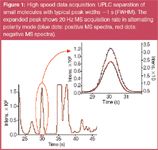
Figure 1
This high information content can be used to search against a spectral library. All 10 components were successfully identified. Table 1 shows the match between the experimental data and the library MS–MS spectra. Peak no. 2 was identified as either tramadol or O-demethylated venlafaxine (correctly identified) because both are structurally related (same elemental composition) and produce the same MS–MS signals. To further distinguish the two compounds, automated data dependent MS3 spectra can be acquired and compared to the library as well. If available, reference retention times of the compounds can be used as a further dimension of information.
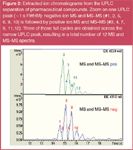
Figure 2
Even the co-eluting compounds no. 5 (clozapine) and 6 (venlafaxine) can be identified, because the amaZon enables fast MS–MS of several components even within the extremely narrow UHPLC peak. This leads to a high score (purity factor) for the library search result (i.e., to an extremely high confidence in the identification).
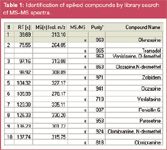
Table 1: Identification of spiked compounds by library search of MSâMS spectra.
The identification of drugs and toxins can be automated using the Bruker Compass OpenAccess software module as it supports push-button experiments for routine screening applications. A very simple user interface on the acquisition PC allows the user to queue the submitted samples for automated data acquisition and processing (Figure 3). Samples can be submitted from any PC in the intranet via a web interface. All information regarding samples, status of the jobs, data, reports and processing results are stored in a database. When the sample has been processed, the spectra, chromatograms and identification results are sent to the user as a PDF report via e-mail or can be accessed via the web interface. Figure 3 shows part of the workflow and the results on eight antidepressants spiked into plasma.

Figure 3
Conclusion
The amaZon was demonstrated as a fast and reliable screening instrument. Library-based identification of compounds was achieved by ultrafast MS and MS–MS under polarity switching within extremely short UPLC gradients. With unsurpassed speed and sensitivity, the amaZon is the instrument of choice for compound screening with spectral libraries.
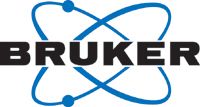
Bruker Daltonik GmbH
Fahrenheitstr. 4, 28359 Bremen, Germany
tel. +49 421 2205 0 fax +49 421 2205 104
E-mail: sales@bdal.de
Website: www.bdal.com
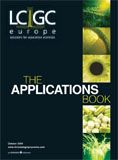
Accelerating Monoclonal Antibody Quality Control: The Role of LC–MS in Upstream Bioprocessing
This study highlights the promising potential of LC–MS as a powerful tool for mAb quality control within the context of upstream processing.
Using GC-MS to Measure Improvement Efforts to TNT-Contaminated Soil
April 29th 2025Researchers developing a plant microbial consortium that can repair in-situ high concentration TNT (1434 mg/kg) contaminated soil, as well as overcome the limitations of previous studies that only focused on simulated pollution, used untargeted metabolone gas chromatography-mass spectrometry (GC-MS) to measure their success.
Prioritizing Non-Target Screening in LC–HRMS Environmental Sample Analysis
April 28th 2025When analyzing samples using liquid chromatography–high-resolution mass spectrometry, there are various ways the processes can be improved. Researchers created new methods for prioritizing these strategies.
Potential Obstacles in Chromatographic Analyses Distinguishing Marijuana from Hemp
April 28th 2025LCGC International's April series for National Cannabis Awareness Month concludes with a discussion with Walter B. Wilson from the National Institute of Standard and Technology’s (NIST’s) Chemical Sciences Division regarding recent research his team conducted investigating chromatographic interferences that can potentially inflate the levels of Δ9-THC in Cannabis sativa plant samples, and possible solutions to avoid this problem.

.png&w=3840&q=75)

.png&w=3840&q=75)



.png&w=3840&q=75)



.png&w=3840&q=75)



















